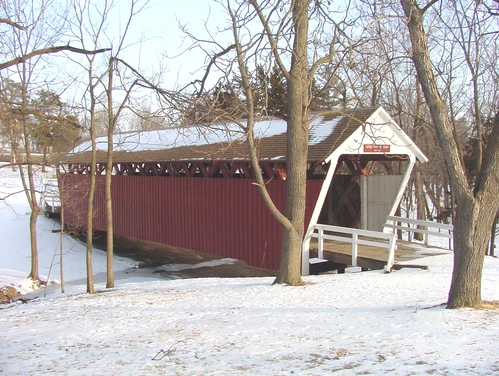- Year constructed: 1871
- Bridge type: Covered Timber Town Lattice Truss
- National Register of Historic Places status: Listed
- Length: Unknown
- Width: Unknown
- Spans: 1
- Jurisdiction: Madison County
- Location: Pedestrian path over a natural depression on the southeast edge of Winterset, Section 31, T76N-R27W (Union Township)
Details
To bridge the myriad of streams, the county board of supervisors ordered numerous short-span timber pile and kingpost structures built in the 1850s and 1860s. Though inexpensive to erect, most of these spans tended to be structurally suspect and required frequent maintenance to prevent their collapse. Moreover, they were restricted to short-span crossings.
With limited funds and an abundance of crossings, the county elected to leave these earliest structures uncovered. This did not pose a serious threat to the timber pile spans, which rarely lasted long enough to suffer damage by rain and snow. But more complex and expensive timber trusses, left open to the weather, proved vulnerable to deterioration in their upper chord connections. For this reason, the county began sheathing its wooden through trusses with shingle roofs and plank siding in the late 1860s.
In 1870, the county supervisors visited the Donahoe, Wiggins and Wilkins fords to determine what order the bridges should be built. The board opted to construct a bridge at the Wilkins Mill first, followed by the Donahoe Bridge over the North River near Bevington. Like all of Madison County's covered bridges, it featured a Town lattice truss, overlaid by a queenpost truss frame. The Donahoe Bridge was completed by June 1871. It carried traffic at this crossing until it was moved to a Winterset city park in 1970. Here it stands over a small natural depression, in well-preserved condition.
Popularized in literature and a recent movie, and visited en masse by tourists during the annual covered bridge festivals, the covered bridges of Madison County are easily Iowa's most famous spans. As a group, they well represent covered bridge technology, which predominated in the state before widespread adaptation of all-metal spans in the 1870s. Built in 1871, the Cutler-Donahoe Bridge is the second oldest of these bridges. It stands in well-preserved condition today.
Adapted from Fraser 1992
Areas Served
- Madison
